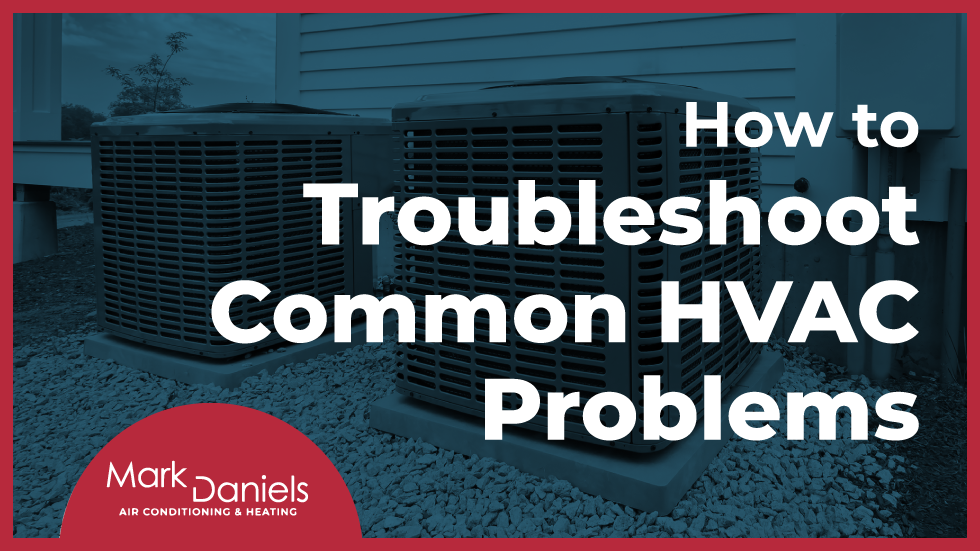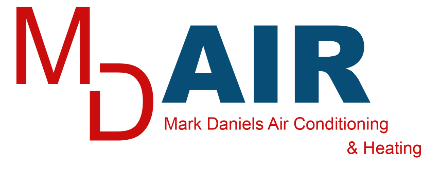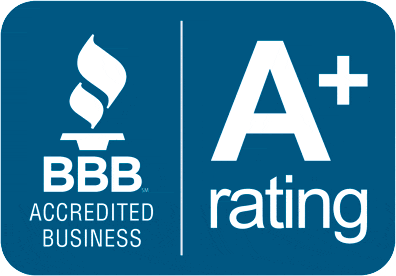Licensed | Bonded | Insured

How to Troubleshoot Common HVAC Problems
Hot and cold, rain and hail. An HVAC system is a bulwark against the forces of nature.
That is until it ceases to work.
Your HVAC system is incredibly resilient and will continue to function long after it needs a tune-up.
But this is a bad idea if you want energy efficiency and less expensive repairs.
Regular HVAC maintenance may be tedious, but it’s a time and money saver in the long run.
To be effective in this, you must learn how to troubleshoot common HVAC problems.
Most HVAC maintenance boils down to simple fixes that anyone can do.
If you take the time with these things, then your HVAC repairs will be cheaper and less frequent.
Not sure where to start? We’ve got you covered.
Keep reading as we discuss how you can troubleshoot common HVAC problems.
Before You Troubleshoot Common HVAC Problems, What Is HVAC, Anyway?
HVAC stands for Heating, Ventilation, and Air Conditioning.
An HVAC system is not one entity, but rather a cluster of systems that work together.
Their purpose is to provide a comfortable atmosphere inside your home.
Your HVAC encompasses some or all of the following components:
- Heating systems, such as heat pumps, boilers, and furnaces
- Ventilation shafts that run through your ceiling and walls
- The air conditioning system, whether a window unit or an all-house unit
- The thermostat that controls the temperature
- Filters that clean the air as it comes in
HVAC servicing is vital as soon as issues manifest.
In most cases, your technician only needs to make a simple fix.
Delay too long, and the cost of HVAC repairs may go up.
All of these systems work together, so a problem with one system might lead to a problem with all.
If you’re not sure what to do, it never hurts to get a technician from your local area.
Winter is here, so now is the best time to take care of these issues.
A cold home is the last thing you want for Christmas!
Frigid temperatures will lead to sickness, even in Arizona where winters require only a light jacket.
With all that said, let’s take a look at the most common HVAC problems, and the ways that you can troubleshoot them.
1. Dirty Filters
Everyone forgets to replace their filters, so don’t feel bad if you haven’t.
Set a reminder on your phone or calendar to swap them out at least once every 6 months.
Filter replacements won’t take more than five minutes.
Make sure to get a ladder so you can reach any ceiling vents.
Keep some fresh filters in storage for when you need them–and make sure they’re the right size.
Replacing filters is crucial because:
- Dirty filters lead to poor air quality
- Your HVAC system has to work much harder to push treated air through the system
- Your electric or gas bills will be higher to accommodate the extra effort needed
- It may take longer to raise or lower the temperature
How to Troubleshoot Dirty Filters
If you notice abnormally high utility bills or poor air quality, filters should be the first thing you look at.
Arizona is so gritty that dust storms occur every year.
That dust accumulates in your filters, which forces AZ residents to replace them more often than in other states.
Phoenix air quality also tends to be notably poor.
Keeping up with your filter maintenance is cheap and easy, but makes your HVAC system run smoothly.
2. A Thermostat Malfunction
Your thermostat is the brains of your HVAC system.
Most thermostats are a cheap motherboard manufactured in China.
All it takes is a burnt-out transistor for the whole thing to go haywire.
Issues with a thermostat may result in the following:
- The temperature does not remain at a consistent level
- The thermostat doesn’t kick on or off at the times that you program it for
- The thermostat is unresponsive, or the HVAC system doesn’t turn on as a result
- The thermostat resets without warning, erasing past settings or programming
How to Troubleshoot a Broken Thermostat
If you notice the above issues, the first thing you can do is check the thermostat battery.
A simple battery swap may be all you need.
Check to make sure the buttons are working and responsive.
Old thermostats have gotten years of wear and tear and may need a replacement.
Often the easiest and cheapest solution is just to get a new one.
Purchasing a smart thermostat can make your life a lot easier for programming and setting the temperature.
Digital thermostats are much more efficient than analog thermostats, so this will save you money.
3. Issues at the Breaker Box
Sometimes, the system may be working fine, but the breaker is the issue.
You may experience the following:
- Your HVAC system cuts out unexpectedly
- The system does not remain on for long even after you switch the breaker back on
- The breaker shuts off almost immediately after you switch it back on
How to Troubleshoot Breaker Issues
In some cases, you may need to replace the breaker or the fuse.
Both of these are easy fixes, but you are dealing with electricity.
You should shut the power off to the whole house when dealing with the electrical box.
However, don’t hesitate to call in your technician.
Don’t risk your life for something that you don’t feel comfortable doing.
Other solutions may include replacing the filters.
An overworked system will draw too much power, tripping the breaker as a result.
Be sure you’re not overworking your system.
Don’t set a temperature that’s too low or high, and don’t leave doors and windows open.
4. Air Conditioning Issues
Arizona residents know full well how hot summer can get in the Sonoran desert.
120 degrees Fahrenheit is not unexpected during a typical July day.
Air conditioning is vital in the Grand Canyon state, and thus A/C issues crop up fairly regularly.
Issues with the A/C may include the following:
- There is no cooling
- Cooling takes a long time
- The system blows hot air instead of cool air
- Temperatures do get cooler, but no lower than a certain point
- Energy bills are abnormally high
How to Troubleshoot Problems With Air Conditioning
First and foremost, check the filters.
Just like with any system in your home, your filters have a powerful effect on performance.
Then, check your air conditioner unit itself.
Thanks to that same Arizona dust, the coils and heat sinks collect a lot of grime.
Most people fail to clean this for many years, which leads to the aforementioned problems.
Power off your system and then use a pressure washer to clean the coils.
You may need to have a professional come by and vacuum the condensation line.
This process is only necessary once every few years.
If this doesn’t work, then you should try topping up the freon.
You need to refill this chemical on a regular basis.
Your local technician can do this in just a few minutes.
Finally, you may just have an old, inefficient unit.
Air conditioners have improved drastically in efficiency just in the past ten to twenty years.
If your electric bill is a big concern, you may be better off replacing your unit.
5. Heating Issues
Most Arizona homes have either a furnace or a heat pump for the winter months.
While Arizona isn’t known for being a cold state, it can get quite nippy in the mornings.
A good furnace is a worthwhile investment even in the desert.
Issues with the furnace may include some or all of the following:
- The heat fails to turn on
- It takes a long time to start up
- The heat does not increase beyond a certain threshold
How to Troubleshoot Heating Issues
Same as always, your first job is to check the vents.
Replace the filters if necessary and remove any potential obstructions around them.
Heating, just like air conditioning, performs based on how good the airflow is in and out of the vents.
Issues with starting may be a result of the pilot light.
This is the gas light that turns on when you initiate heat on the thermostat.
This may require some cleaning or a complete replacement.
Other issues may arise from a bad blower on the furnace.
If you hear a squealing or whining noise, it might be a good idea to check the fan for replacement.
As with everything else on this list, you should contact a technician at the first sign of problems.
You’re working with electricity and appliances that can cause high heat.
Play it safe and let a professional fix any issues beyond a simple filter replacement.
Contact Mark Daniels for All Your HVAC Servicing and Repairs
Learning how to troubleshoot common HVAC problems can improve your energy efficiency and extend the lifespan of your system.
Most regular HVAC maintenance boils down to routine filter changes or breaker replacements.
However, don’t hesitate to speak to a professional when an issue arises that you cannot fix on your own.
Mark Daniels serves the AZ community from Buckeye to Tempe.
Whether you need some regular HVAC maintenance or full-blown repairs, Mark is here to help.
Contact us today and make your home ready for winter and beyond.
Have you run into an HVAC issue that you aren’t able to handle yourself? We’ve got you covered! Our experts have been helping property owners in Mesa, Gilbert, and Chandler, AZ, troubleshoot common HVAC problems and get them fixed quickly. If you’re looking for an HVAC company in Gilbert, Mesa, Chandler or beyond, Call (480) 571-7219 or request service online today!
Read More about Air Conditioning & Heating Tips:



